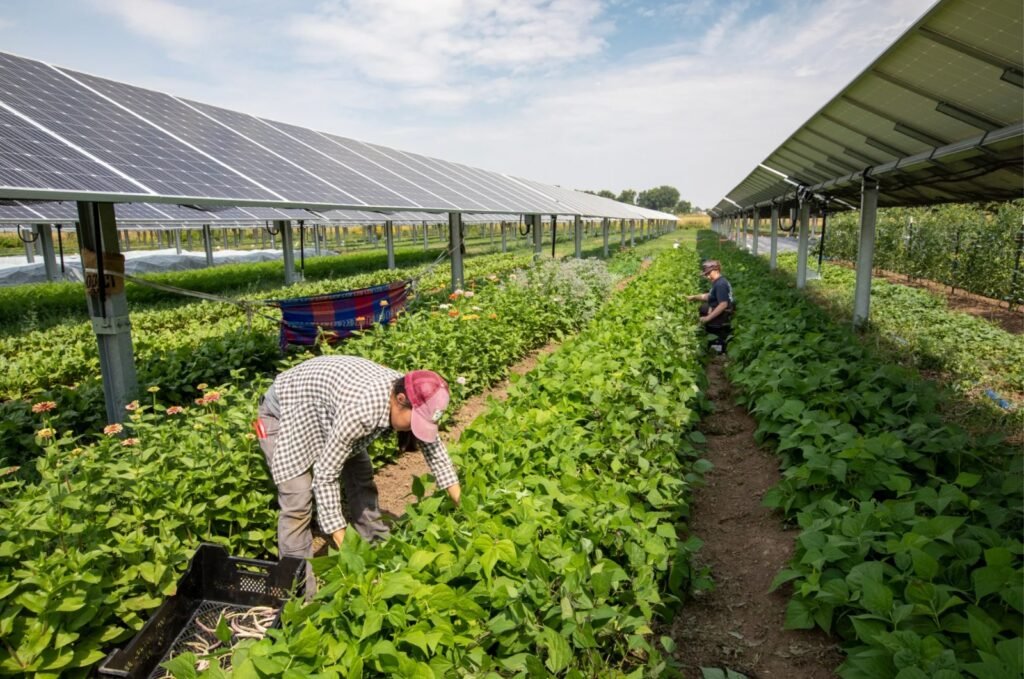Cotton: Pakistan is among the ancient homes of cotton, with traces found in Mehrgarh dating back to 5000 BC. The crop spread to the Indus Valley and remains central to the economy today. Pakistan is the 5th largest cotton producer and 3rd largest yarn producer globally. Around 1.3 million farmers grow cotton on 6 million acres, covering 15% of cultivated land. Cottoncontributes 0.8% to GDP, 5.2% to agriculture value addition, and 51% to foreign exchange earnings. The crop supports a vibrant textile sector, including 1000 ginning factories, 400 textile mills, thousands of looms, knitwear, and garment units nationwide.

Can agriculture and solar energy work together instead of competing? A study led by Maddalena Curioni, Nikolas Galli, Giampaolo Manzolini and Maria Cristina Rulli, researchers in the Department of Civil and Environmental Engineering and the Department of Energy at the Politecnico di Milano, sheds new light on the potential of agrivoltaics.
Published in the journal Earth’s Future, the paper analyzes how the coexistence of photovoltaic panels and agricultural crops can help solve the global conflict over land use.
With the growing demand for renewable energy and the need to produce increasing amounts of food, the pressure on arable land is intensifying. Today, between 13% and 16% of ground-mounted photovoltaic installations occupy land that used to be agricultural, a sign of agriculture and energy competing for the same space.
But there is a third option. The study reveals that between 22% and 35% of non-irrigated agricultural land around the world could host agrivoltaic systems while continuing to produce food. It presents an opportunity to integrate two basic needs without compromising one or the other.
To reach these conclusions, the researchers used a spatial agro-hydrological model, simulating the response of 22 crops to the reduction in solar radiation caused by the panels. The model enabled an assessment of potential crop yields in different climates and geographical areas, resulting in a global map of possible places to apply agrivoltaics.
“Agrivoltaics cannot be applied everywhere, but according to our results, it would be possible to combine cultivation and energy production in many areas of the world without significant reductions in yield,” says Galli, Glob3Science Lab researcher and co-author of the study.
Global distribution of rainfed areas harvested and/or convertible to agrivoltaics for the scenarios that produce the lowest (a) and highest (b) convertibility globally. (a) corresponds to 50% of radiation reaching the crops and allowing only for yield maintenance or increase, while (b) corresponds to 90% of radiation reaching the crops and allowing for up to 20% yield reduction. Both harvested and convertible areas are represented as pixel percentage. The bivariate color scheme works as follows: the gray-shaded column corresponds to harvested, non-convertible areas (convertible areas = 0%). The triangular colored scheme changes color tone (vertically) according to harvested areas and color shade (horizontally) according to convertible areas. The scheme is triangular because convertible areas cannot be more than the harvested areas. Credit: Politecnico di Milano
“Using the land for both cultivation and photovoltaic systems increases overall output per occupied surface area while reducing production costs. In addition, installing crops underneath the photovoltaic panels reduces the panel operating temperature and increases their efficiency,” adds Manzolini, professor in the Department of Energy and co-author of the study.
“This technology could help reduce land competition while improving the sustainability of agricultural and energy systems,” concludes Rulli, lab coordinator and co-author of the study. The results provide a sound scientific basis for guiding policy choices and investments for more efficient and sustainable land use. TX
